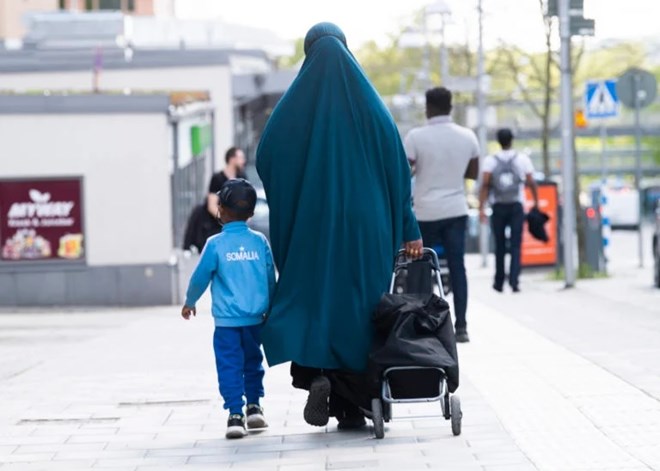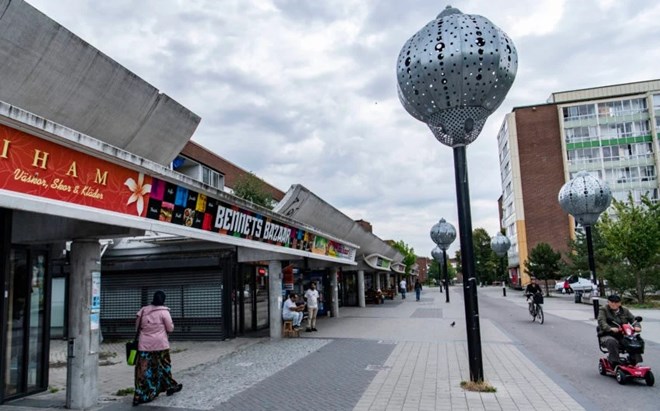
Friday September 2, 2022

A Somali woman walks with her child in Rinkeby a "specially vulnerable area" in Stockholm. Photo: Fredrik Sandberg / TT
Immigration is looming large as a topic in Sweden’s 2022 general election.The far-right parties have often taken a harsh stance towards immigrants, so there is nothing new in the “Sweden is for the Swedes” brand of ethnonationalism offered by the Sweden Democrats. What is new is the Social Democrats’ embrace of this harsh rhetoric, combining the complicated social problems of segregation, struggling schools, and gang violence under a single heading: “failed integration”.
Prime Minister Magdalena Andersson’s comments in a recent interview with Dagens Nyheter sum up the view that the visibility of immigrants and immigrant spaces is a barrier to integration and social cohesion.
“We do not want to have Chinatown in Sweden, we do not want to have Somalitown or Little Italy, our starting point is a society where people with different backgrounds, experiences and income live together and meet one another. That’s how we will create a cohesive society.”
Below are six reasons why this is the wrong approach.
1. The idea that ethnic enclaves are a barrier to integration is inaccurate
The starting point for building a cohesive society is creating places where there is a mixing of languages, cultures, religions, experiences, and economic situations. If this is so, the Social Democrats should be embracing immigrant neighbourhoods instead of condemning them.
Rinkeby, in Stockholm, includes people with backgrounds from Somalia, Iran, Iraq, Turkey, Ethiopia, Greece, Poland, China, and Sweden, to name just a few. Many who live in the neighbourhood develop a strong sense of attachment and belonging that transcends national backgrounds.
Andersson’s colleague, migration minister Anders Ygeman recently discussed a goal of having neighbourhoods where only about 50 percent of people are foreign-born. According to the statistics on Rinkeby-Kista provided by the city of Stockholm, about 52 percent of the neighbourhood is currently foreign-born. Pretty close to the Social Democrats’ goal!
Of course, an additional 33 percent of the neighbourhood are Swedish citizens with two foreign-born parents. Apparently, these Swedes with foreign backgrounds do not count as sufficiently Swedish, and the Social Democrats are talking about “ethnic Swedes”.
2. Sweden’s suburbs are segregated because Swedes choose not to live there
If there are few ethnic Swedes in Rinkeby or other immigrant neighbourhoods, that is because Swedish people are choosing not to live there.
The self-segregation of the majority population is usually what drives segregation, and it’s the ethnic majority in Sweden, and in most countries, that is the most isolated and the most segregated. Typically, the members of the ethnic majority prefer less neighbourhood diversity than people from diverse backgrounds. Just this difference in preference is enough over a lot of people’s housing choices to drive segregation.

Bennets Bazaar in the Malmö district of Rosengård back in 2018. Photo: Johan Nilsson/TT
3. Immigrants living near one another is normal
It’s difficult to arrive and adapt to a new country, and immigrants often settle near one another and develop networks with each other. They do this as a way to adapt. Immigrants frequently experience a negative impact on their credentials and their social standing as a result of migration, and people from the home country are more likely to recognise that lost status.
They are also encountering a new bureaucracy, the migration system, and a new set of laws and social norms, often without the benefit of knowing the language in advance. Often other immigrants that have gone through the same thing are the people who are best equipped to help them.
Other immigrants from the same background can also provide comfort in providing connections to the home culture and language, and acting as a surrogate family when it comes to celebrating holidays or managing big events like funerals and weddings in ways that are familiar and comfortable.
4. Immigrant neighbourhoods actually facilitate integration
Criticising immigrant neighbourhoods is counterproductive, since immigrant neighbourhoods have been shown to have a role in helping immigrants into society. One important pathway to integration and social cohesion is through the formation of immigrant organisations and community groups in such neighbourhoods. When governments embrace these neighbourhoods and partner with immigrant community organisations, people feel a greater sense of belonging, they’re more likely to acquire citizenship and to do it more quickly, and they’re more likely to participate in the political process.
This is a problem in Sweden. There was a study asking why Somali immigrants in Sweden struggle in comparison with Somali immigrants in the UK, the US and Canada. One of the main conclusions was that Somali immigrants, wherever they arrive, generally feel that it’s important to build Somali community organisations and local Somali identity. In most of the countries studied, the government embraced this. Through their involvement in that organisation, and through the organisation of a Somali community, there was this pathway to more society cohesion at the level of broader community.
What the report concluded was that in Sweden, there has been resistance and suspicion when these groups arise. The perspective on the part of the state has been that the rise of these kinds of groups signals a parallel society and signals social distrust.
5. Stigmatising neighbourhoods as “parallel societies” makes integration more difficult
When immigrant neighbourhoods persist over generations, there are two likely reasons. If there is continued migration, new people are coming to the neighbourhood, keeping the neighbourhood alive, even though many of the children and grandchildren of earlier immigrants have likely moved away.
If neighbourhood residence persists across multiple generations of the same family, then we should become concerned about the persistence of the neighbourhood as a result of prejudice and social exclusion.
In Sweden there is both continued immigration and documented discrimination against people with foreign backgrounds in many areas of society, including the job market, access to credit, and involvement in politics. Stigmatising these neighbourhoods makes integration even more difficult.
6. Gang criminality and immigrant neighbourhoods are linked, but not in the way the Social Democrats think.
There certainly is an observed link between gang involvement and immigrant neighbourhoods in the literature. The research consensus is that marginalisation of immigrants in the new country facilitates the rise of gangs in immigrant neighbourhoods. Young people are also most vulnerable to gang recruitment. So, if you have a young immigrant population, you tend to see more of these problems.
Stigmatising immigrant neighbourhoods, and even policies to eliminate these neighbourhoods, doesn’t get at the underlying problem. Instead of taking a sledgehammer to entire communities, a targeted response identifying key actors in criminal networks together with programmes for the youth who are most at risk for joining gangs is shown to decrease gang violence.
Again, the key to immigrant integration and social cohesion is actively embracing and working with these communities. So instead of them being isolated and stigmatised, immigrant neighbourhoods, that the ethnic enclave becomes a bridge into Swedish society.